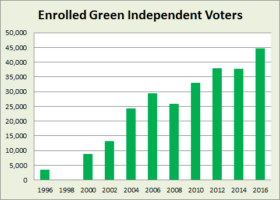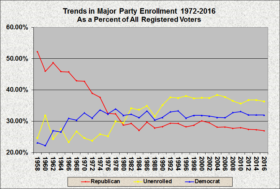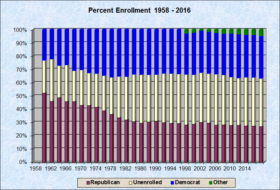For the nearly 100 years from 1857 through 1954, the Republican Party dominated the state’s politics. Thirty-one Republican governors served during the period, compared with four Democrats.
During the 1950s and 1960s Republican enrollment began to slide as Democrats and unenrolled voters became a larger portion of the electorate.
Registration is the process for “signing up” to vote; enrollment is an additional process for selecting membership in a political party or remaining unenrolled. Since local registrars of voters purge their lists of people who have died or moved from the community, total numbers of registered voters may decline because some of those previously listed are no longer eligible. However, since the efforts to maintain up-to-date voter lists varied widely among Maine towns, the total number of reported registered voters has often been larger than the actual number of potential voters.
Recently a statewide voter registration database was established in the Maine Secretary of State’s Office. Local registrars now follow uniform procedures and enter data directly, reducing some of the variations among communities.
2008 was the first year in which the statewide computerized voting list was in use. This might explain the apparent drop in registered and enrolled voters, with the elimination of duplicates and the more effective removal from the rolls of deceased voters and those who have moved.
Registration totals were first reported to the Secretary of State in 1958 for the November general elections; the number of unenrolled were first reported in 1972 for the June primary elections. Because of the five month difference, the comparable number not enrolled in one of the two major parties may only be estimated by subtracting Republicans and Democrats from the total registered between 1958 and 1972.
Recent major “other parties” are as follows:
1996 – Reform (22,496); Green (3,437)
1998 – Reform (17,700); Green (none, decertified)
2000 – Reform (3,114); Green Independent (8,743)
2002 – 2016 Green Independent.
The Greens have more than tripled their numbers from over 13,000 in 2002 to 44,569 in 2012.




